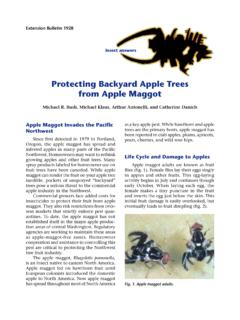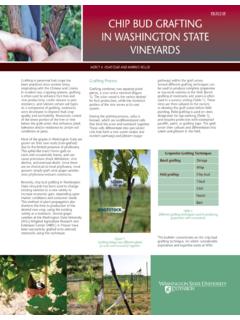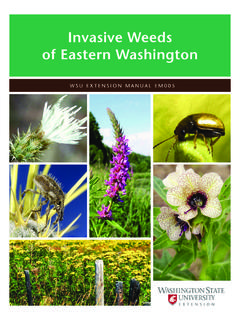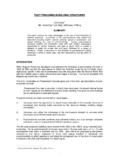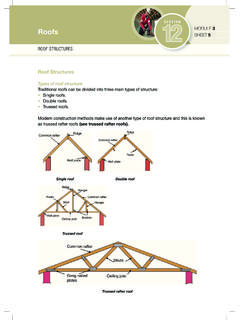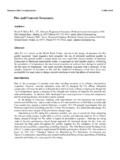Transcription of PnW164 Propagation of Plants from Specialized …
1 PnW164 . Propagation of Plants from Specialized Structures Kum a r , W. E . Gus e , F. E . L a r s e n INTRODUCTION Plants . Refer to Table 1 (page 10) for a summary of Specialized structures and the plant parts involved Most Plants reproduce sexually from seeds, but in their development. some can be reproduced (or multiplied) by vegeta- tive parts such as stems, roots, and leaves. In addi- Underground Stem Modifications tion, some Plants produce modified stems and/or roots, referred to here as Specialized structures that Bulbs accumulate food reserves and therefore have built-in regeneration potential and are valuable as vegetative Bulbs consist of a growing point (stem or shoot propagules.)
2 Plants with Specialized structures are tip) surrounded by layers of modified fleshy leaves well-suited for asexual Propagation . For example, designed to store food reserves. Both the growing potato tubers are modified stems that store starch; point and the leaves are attached to a compact stem such swollen underground structures known as tu- located at the base of the bulb called a basal plate. bers serve as a seed for raising commercial potato Thus, bulbs contain both stem and leaf tissue. See crops. Other Plants produce Specialized structures to Fig.
3 1 (A and B) for a longitudinal section of a bulb. survive under unfavorable conditions and resume growth when conditions become favorable for their survival. A B. Terminal bud Some Plants have growth habits that facilitate vegetative Propagation . Such structures usually originate from stems, roots, and sometimes leaves. For example, strawberry and spider Plants produce horizontal stems known as runners. Run- Tunic ners can produce roots and develop new plantlets at particular nodes on the run- Fleshy leaves ner. Rooted runners can be detached from the mother plant and grown as indepen- dent Plants .
4 Basal plate (condensed stem). Plants produce a variety of Specialized Fig. 1. Longitudinal sections of hyacinth (A) and tulip bulbs (B). structures useful in plant multiplication Bulbs are modified structures derived from a stem and leaves. The or reproduction. This publication offers stem is compressed into a base plate carrying flowers or vegetative some basic information and guidelines buds. Fleshy leaves with carbohydrate reserves surround the buds in that can increase the success of your ex- a concentric manner. When planted, adventitious roots grow from perimentation with new ways of growing the basal plate.
5 The buds develop into flowers on the new plant. A PACIFIC NORTHWEST EXTENSION PUBLICATION. WASHINGTON STATE UNIVERSITY OREGON STATE UNIVERSITY UNIVERSITY OF IDAHO. There are two types of bulbs, known as either tuni- crowding and produces better quality and larger cate (Figs. 1 and 2A and B) or non-tunicate (scaly) bulbs. Dig tunicate bulbs, such as snowdrop and bulbs (Fig. 2C), and either can be multiplied asexu- narcissus, after the leaves die back. Earlier digging ally. Onions, composed of concentric layers of reduces bulb size and subsequent flower quality.
6 Fleshy leaves, are tunicate bulbs because the outer layers of leaves dry and form a protective tunic If you choose to dig and store tunicate bulbs an- (covering). Lilies are non-tunicate bulbs because nually, avoid drying them in the sun, as this can their leaves are fleshier and overlap each other, cause scalding. Clean them well after drying by giving a scaly appearance. Since non-tunicate bulbs brushing off dried roots and soil. Store tunicate do not have a protective tunic, they are easily bulbs in trays with wire mesh bottoms to provide damaged and susceptible to desiccation.
7 For best adequate ventilation. To prevent root development results, store non-tunicate bulbs in polyethylene and mold growth while in storage, maintain a hu- bags containing moist sawdust or sphagnum moss. midity that will keep the bulbs dry, but not so dry as to shrivel usually around 75 percent. Unless Many fall-planted bulbs will flower outdoors. Some otherwise specified, store tunicate bulbs at about bulbs lack winter hardiness and must be stored over 80 F (27 C) for the first two weeks after digging winter for spring planting. Table 2 (page 11) pro- to cure them, and then lower the temperature to vides information about the hardiness of various around 48 F (9 C) until you plant them.
8 If stored types of bulbs. at higher temperatures, the bulbs may not flower properly. An underground cellar usually provides a Propagation of tunicate bulbs good storage temperature after curing. The most common approach is to simply leave tu- nicate bulbs in the soil between occasional diggings Offsets: The simplest way to produce more and replantings. The resulting Plants may form Plants from tunicate bulbs is to use offsets. dense colonies, but many prefer this as a natural Offsets are small bulbs that develop naturally look. Alternatively, digging annually prevents over- from parent bulbs.
9 You can enhance tunicate A B C. D F G. E. Fig. 2. Examples of modified plant structures derived from stems and produced underground. Tunicate bulb of onion (A) and garlic (B), non-tunicate bulb of lily (C), tubers of potato (D) and Jerusalem arti- choke (E), corms of gladiolus (F), and rhizomes of ginger (G). 2. Basal plate Untreated bulb (A). A B C. Scooping (B, C) Scoring (D). Coring (E) Sectioning (F) D E F. Fig. 3. Variously treated hyacinth bulbs for propagating (A F). Note the development a of bulblets from cored (a) and scooped (b) bulbs. bulb Propagation by digging parent bulbs, and separate when the separating, and planting.
10 Small offsets will usu- foliage is yellow and ally produce only leaves the first year; do not dry. Although scooping expect flowers until the second year or later. In produces 25 to 50 bul- Fig. 2A, the smaller bulb developing to the left blets per mother bulb, of the larger bulb is an offset. Some Plants , such these will be small and b as hyacinths, do not readily form offsets and may require four or five therefore require artificial stimulation in the years before flowering. form of scooping, scoring, coring, or sectioning Scoring: To score a to induce new bulblets.
